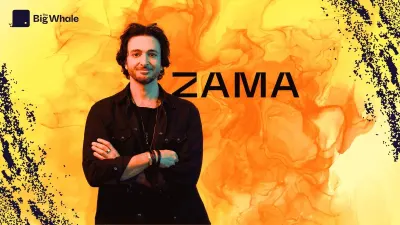From Web1 to... Web3 "Web3". For the past few months, or perhaps only for the past few weeks, you've been hearing this term bandied about, no doubt wondering, "what the hell is it?" And you're not alone. To answer this question, we need to go back a little, and more specifically to the birth of the Internet in the early 1990s.
At the time, cryptos didn't exist, the Internet was a " simple " communications network. To use it, you had to go through websites, which were relatively basic to use. The sites allow you to read and consult information. Companies set up their first sites to display products, commercial offers and even their physical address! Internet users set up mailboxes and began exchanging information with each other online... This period corresponds to what is known as Web1.
Things were to accelerate in the 2000s, when the Internet gradually made it possible to browse and share content, particularly multimedia content (images, videos...). Websites were no longer static, but dynamic. This was the beginning of social networking, with smartphones and the emergence of future giants such as Meta (formerly Facebook) joining other market leaders such as Google and Amazon. This was the period of Web2, or more commonly the mobile Internet.
The emergence of Web2 enabled the development of new means of communication. The telephone giants have been (largely) eclipsed by the tech giants and social networks like Instagram, which are at the heart of this new Internet. The fact remains that this Web2 is highly centralised. Google and the other giants concentrate all the data of billions of users, enabling them to generate colossal revenues.
It is precisely in reaction to this movement towards Internet concentration that what is known as "Web3" was born. The first person to talk about it was Gavin Wood, one of the co-founders of Ethereum, which is now the second largest blockchain on the planet.
What is Web3? Don't worry, Web3 is not a parallel world or an Internet for Martians. It is as we know it, with websites and applications. Except that it also has a new layer based on blockchain technology and cryptos. And this layer is fundamental in that it brings digital ownership to our societies.
Until now, you couldn't own anything on the web: not your currency, not your digital "objects", not your identity... Everything was held by trusted third parties, intermediaries like your bank, your phone operator, your favourite social network.
With blockchain and cryptos, there's no longer necessarily any need for intermediaries. Technological innovations allow you to own and manage your data, your digital identity, your money yourself.
How to hold your data? To hold and manipulate these cryptos, in fine to have control over your assets, you need wallets, i.e. digital wallets.
These wallets can be physical. In this case, they often have the appearance of a USB key. The world leader in this sector is none other than Ledger from France. Digital wallets can also be dematerialised applications. This may seem more practical, but it's also a little riskier (particularly in the face of potential piracy).
The wallet is the second Web3 reference tool. It allows Internet users to store all their digital data, cryptocurrencies and other 3.0 objects such as NFTs. In terms of use, it's also a big change since this system will enable people to manage their digital identity differently.
The most obvious example is logging in to all online sites and subscriptions. Until now, we enter our IDs and passwords to log in, and it's the tech giants that hold this data. With the system of wallets and other cryptocurrencies, it is now Internet users who control the data.
Why is Web3 so successful? The Internet was designed to enable everyone to communicate and exchange with everyone else. At least, that was the original idea, still held by some members of the community. But in the space of twenty years or so, the Internet has evolved considerably. Far from being a global network controlled by everyone, it is above all dominated by the tech giants who have a stranglehold on Internet users' data.
Part of the success of Web3 comes in particular from the desire to "reappropriate" the Internet.
The success of Web3 is also economic. By giving ownership of data back to users, Web3 allows Internet users to recover the "value" of their data and have control over it. One well-known example is items (objects) in video games. If you buy an item in a video game, such as an accessory or a suit of clothes, you do not own it. If the game's creators delete your account or if the game itself disappears, you will lose these items. If you stop playing, you also lose what you have invested. With Web3, on the other hand, you own the items and no one, not even the game publisher, can take away ownership of your digital object. And if you stop playing, no entity, not even the game's creators, has the power to take away your ownership. And if you stop playing, you can sell or trade your objects.
The appeal of Web3 is also linked to the concept of the community dimension. In the words of French sociologist Guy Rocher "Belonging to a community means sharing enough common ideas or traits with other members to recognise oneself in the 'we'." Owning assets such as NFTs fosters this sense of belonging. It is this logic in particular that has been used by the studio Yuga Labs in communicating its famous NFT Bored Ape collection.
This is why, in the evolution of Web3 DAOs (decentralised autonomous organisations) are a fundamental part of the decentralisation narrative. Unlike traditional, centralised organisations where decision-making is concentrated at the top, DAOs use smart contracts to give each participating member a voice. Once again, Web3 gives users a voice. The digital world belongs to no-one but everyone. Democratic potential is a drastic point in the evolution from Web2 to Web3 for our societies.
What are the limits of Web3? The future of Web3 is not set in stone. It's still a contested concept and it's provoking debate. So, are we heading for the best of all worlds? Or the worst of nightmares?
To find out, we need to immerse ourselves in the metaverse, the virtual world sketched out by Neal Stephenson in The Virtual Samurai in 1992, which would be an extension of our identity. Public interest in the metaverse has exploded in recent months. Particularly among businesses. Meta (formerly Facebook) alone has spent more than $10 billion on metaverse technologies by 2021.
The cypherpunks behind these projects wanted to think of metavers as a way of beating death through the development of a virtual version of our lives. Is this promise enough to lump it in with the web3 revolution, when the metaverse is being driven in particular by Meta, one of the flagship companies of web 2.0 and a symbol of a centralised vision of the internet?
It's difficult to answer, but we can't avoid the subject. It's an important question to consider when the intrinsic values of Web3 are decentralisation and control of its data. It is clear that Web2 companies are taking this challenge seriously if they are not to be left behind by the new players. They are deploying new dedicated branches within their institutions. This is particularly true of Meta, of course, but also of the Alphabet group (parent company of Google), which is the biggest investor in Web3 start-ups, with a contribution of 1.5 billion dollars according to Blockdata.
As you will no doubt have realised, there is a lot of talk about money and investment in this ecosystem, and this could in fact be one of its limits. The tokenisation process, which consists of digitally representing an asset on the blockchain, has many advantages. Nevertheless, the spectre of a world in which every object, every asset could be a financial security looms large, raising fears that these technologies could go astray. That's why, in the interests of widespread adoption, there is a real need to inform the public. Education is surely the key to the future of web3. It's by explaining to everyone what web3 and blockchain are, that we'll avoid aberrations and that the sector will become firmly anchored in our daily lives.
Heading 1 Heading 2 Heading 3 Heading 4 Heading 5 Heading 6 Lorem ipsum dolor sit amet, consectetur adipiscing elit, sed do eiusmod tempor incididunt ut labore et dolore magna aliqua. Ut enim ad minim veniam, quis nostrud exercitation ullamco laboris nisi ut aliquip ex ea commodo consequat. Duis aute irure dolor in reprehenderit in voluptate velit esse cillum dolore eu fugiat nulla pariatur.
Block quote Ordered list
Item 1 Item 2 Item 3 Unordered list
Text link
Bold text
Emphasis
Superscript
Subscript









